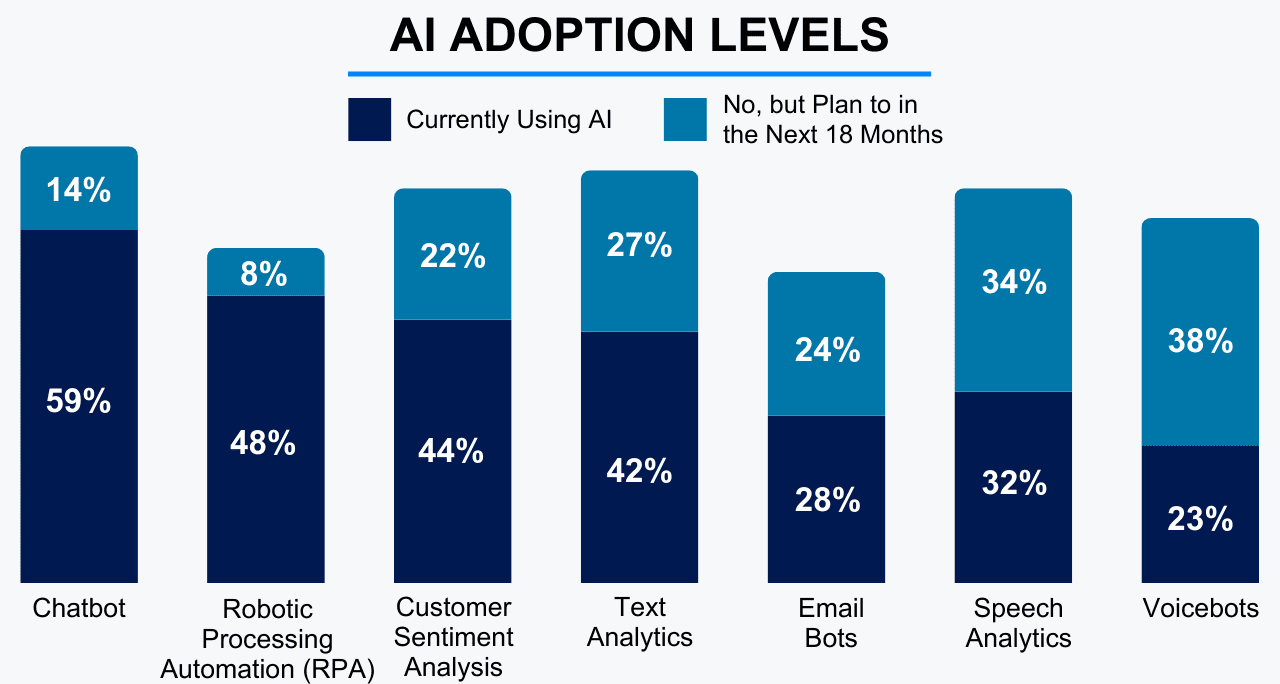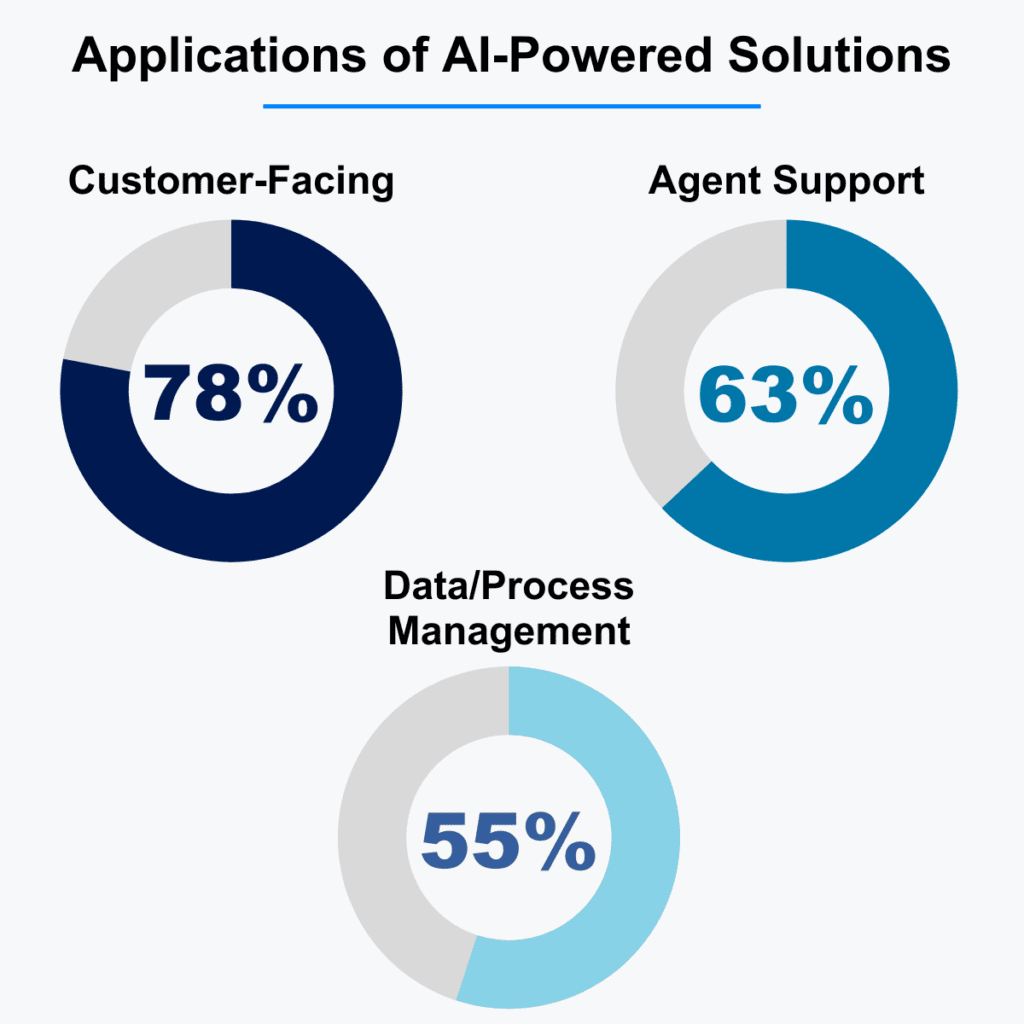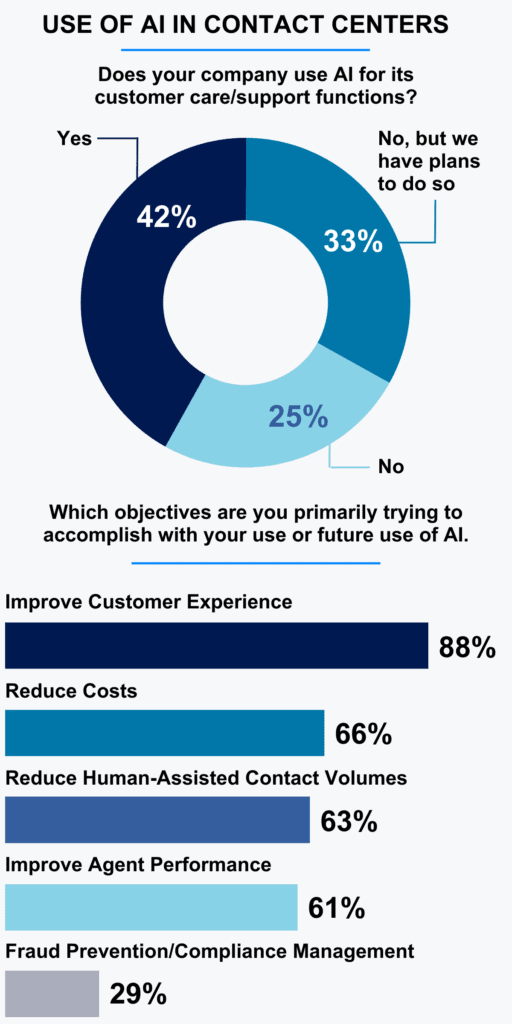
April 9, 2024
The challenge of keeping pace with changing customer expectations looms large. Technological advancements, notably artificial intelligence (AI), fuel customer experience transformation.
Companies worldwide are grappling with leveraging technology to enhance the overall customer experience (CX). This pursuit includes engaging employees, reducing operational costs, and boosting product and service performance.
The technology adoption chasm has moved us past the initial stage, where early adopters experiment with their customers. Today, the field of CX is a dynamic arena where mature technology applications seamlessly integrate to enhance user experiences.
Over the past two decades, numerous strategies and tools have developed. With the advent of generative AI (GenAI) and large language models (LLMs), we are in an era of exponential change.
This phase is about embracing new technologies and utilizing them as substantive, value-adding instruments.

Research
Global Benchmarking Series | Contact Center Technologies
This report explores the adoption and application of the most used technologies, tools and workflows
Groundswell of Digital Innovation
In the global contact center industry, technology use cases fall into three broad categories:
- Agent-assist technologies span solutions that improve agent recruitment, training, and performance to systems for knowledge sharing and automated transcription. They extend to tools for answering customer queries, feedback and coaching systems, and virtual collaboration.
- Customer-facing technologies encompass a range of AI-powered tools for direct customer interaction. These include AI-driven voice bots, chatbots, mobile apps, kiosks, and web tools.
- Operational efficiency technologies extend to applications that provide real-time analytics, prompts, and AI-driven tools for insights and reporting.
Today, executives deploy digital solutions with increased confidence and swiftness. At the same time, the digital ecosystem is broadening the scope and impact of these technologies across various industries.
Contact Center Training: A Digital Leap Forward
The way we train new hires at contact centers has changed drastically. Tech innovators use AI to minimize the financial burden of training new agents and significantly improve training quality.
Personalized Agent Training
The adoption of digital gamification is a major component of this change. According to The Tech Report’s Gamification Statistics and Facts, 70% of the 2000 leading companies actively use gamification. This approach moves away from traditional methods, making training more engaging and interactive.
Digital Avatars in Training Programs
Another training method gaining traction is the use of digital avatars. In our consulting work, we have seen a dramatic increase in organizations deploying these virtual guides for self-paced, continuous training sessions. This method offers a more personalized and adaptable training experience.
Bot-Based Training
Perhaps the most notable trend we’ve seen in our consulting work is the emergence of bot-based training systems. During training sessions, bots can instantly highlight mistakes and recommend ways to improve. What’s remarkable is the speed of adoption; just a few years ago, bot-based training was virtually non-existent.
A New Era in Contact Center Training
These changes in contact center training methodologies mark a broader digital innovation trend. These advancements are not only reshaping new hire training but are also setting new benchmarks for efficiency and effectiveness in customer support.
AI at the Heart of the Digital Customer Experience Transformation
COPC Inc. research shows that a sizable percent of organizations (42%) currently use AI for customer support or plan to do so, signifying a trend toward adopting AI in customer care functions.
We found that AI applications in contact centers serve two critical functions. The first is to enhance the customer experience, a goal most businesses share (88%).
The second application of AI is cost reduction – an equally important target for companies striving for efficiency and sustainability (66%).
Our research found that an overwhelming majority acknowledge these as their primary objectives.
By improving self-service channels, AI facilitates a more efficient and user-friendly customer service experience.
The Expanding Reach of AI in Customer Engagement
As AI tools become more practical for commercial applications, we’re seeing a surge in their adoption. Many businesses currently leveraging AI for customer-facing roles are looking ahead.
Our data below shows that a substantial number of users are either using AI or planning to implement the technology. This proactive approach demonstrates businesses’ commitment to staying at the forefront of AI technology.

Focus Areas for AI Advancements
We are moving beyond the era of traditional AI, which is marked by basic, rule-based systems and elementary machine learning. These early forms of AI, limited in scope and adaptability, primarily automated straightforward tasks without the complex, data-driven understanding of today’s AI.
Modern AI, employing sophisticated techniques like deep learning and neural networks, goes beyond basic automation. Today, it offers advanced, learning-driven solutions that redefine customer service.
Conversational AI: Bringing Human Touch to Chatbots
A key area where AI is progressing is making customer chats more conversational and human-like. Advanced AI models transform formulaic responses into more human and engaging interactions, especially those utilizing LLMs.
AI-powered chatbots can now better understand customer queries and respond in a way that mirrors natural human conversation. This development from robotic responses makes the chat experience more relatable and satisfying.
Deeper Customer Insights: Understanding Beyond Words
Interaction analytics, driven by AI, provide a deeper and more nuanced understanding of customer communications. Speech-to-text conversion tools are now part of a broader suite that includes sentiment analysis and contextual awareness.
This capability enables contact centers to understand what customers say and their underlying emotions and intentions. The technology provides more intuitive and personalized responses to meet individual needs.
AI-Powered Personalization in Customer Service
AI’s capacity to personalize is another game-changer. AI systems can track customer history and preferences, leading to highly personalized service experiences. This level of personalization ensures that customers feel understood and valued.
Streamlining Customer Operations with AI
Beyond the customer interface, AI is improving operational efficiency. From managing call volumes through predictive analytics to streamlining processes with AI-driven insights, operations are smoother, more efficient, and cost-effective.

Related
CX Technology Consulting
Fusing technology and expertise to design and deliver exceptional service journeys.
Optimizing AI Systems for Customer Engagement: A Strategic Framework
The performance of AI-powered systems in customer service hinges on a strategic framework that spans two critical dimensions: the scope of customer inquiries (open or closed) and the duration of interaction (long or short) between the customer and the tool.
Effectiveness in Closed Domains and Short Interactions
When we talk about “closed interactions,” we refer to customer inquiries or issues that are very specific, well-defined, and require a straightforward and clear answer. These interactions are generally quick and do not require extensive back-and-forth communication to address the customer’s needs.
Take this scenario: A customer contacts a retail company with a specific question about the store’s operating hours, a classic example of a closed interaction. The customer has a clear and specific question, and once they receive the store’s hours, the interaction is complete.
In such cases, employing basic rule-based chatbots with an intuitive interface can be remarkably efficient. These chatbots promptly and accurately respond to such customer questions. This method has proven effective in various situations across numerous industries
Generative AI for Extended Interactions
“Extended customer interactions” encompass those scenarios where customers and support agents or AI systems engage in more complex, in-depth, or detailed conversations. Unlike brief exchanges, these interactions often involve several rounds of communication and a deeper grasp of the customer’s specific needs.
Consider, for instance, a scenario where a customer contacts a tech support line for assistance with a complex computer software issue. In this type of extended interaction, there’s typically an ongoing exchange of information.
The customer describes the problem in detail, while the support agent or AI tool provides step-by-step instructions and solutions. It effectively decodes the customer’s detailed descriptions and offers solutions in real time.
Deep Learning Bots for Open Domains and Brief Interactions
An “open” domain refers to customer queries that span a wide range of topics or subjects without being restricted to a specific area or type of question. Given that these interactions are brief, quickly providing accurate and relevant information is the challenge.
Picture a customer engaging with a chatbot on a bank’s website. The customer’s queries might cover a variety of banking services. Initially, they might ask about the process for opening a new savings account. They could then inquire about the latest foreign exchange rates and seek information on applying for a mortgage loan.
In this “open” domain of banking services, the chatbot needs to be versatile with advanced deep learning skills and an extensive knowledge base.
Artificial General Intelligence for Complex Scenarios
Lastly, in the most complex scenarios, “open with a prolonged interaction” implies that the inquiries span a variety of topics and require extended dialogue. These scenarios demand more sophisticated responses, making them ideal for artificial general intelligence-based bots or similar advanced systems.
For example, when a customer plans a complex international trip and contacts a travel service. Their inquiries might include visa regulations, health safety guidelines, flight and accommodation options, and local customs.
This type of discussion requires an AI tool that understands a wide range of topics while also maintaining a coherent and helpful conversation over an extended period.

Webinar Series
A Vision for AI in Customer Support
This webinar series explores the potential of AI to revolutionize both front-end processes that impact customer interactions and back-end operations.
Embracing the Digital Revolution: A New Era for CX
Customer experience transformation is at the forefront of a digital revolution, necessitating the adoption and integration of new technologies. We’ve explored the various aspects of this change, from enhancing employee engagement and reducing operational costs to boosting product and service performance.
This new era of customer service is marked by enhanced interactivity, engagement, and efficiency. It refines conversational interfaces, offers deep insights into customer emotions, and personalizes interactions.
AI will increasingly become embedded in the tools we use, redefining how we work and communicate and ultimately reshaping customer engagement for the better.
Optimizing Your CX Strategy for Customer Experience Transformation
Creating a remarkable customer experience demands foresight, expertise, meticulous planning, and near-perfect implementation. How can AI elevate your customer care operations to new heights of efficiency?
COPC partners with prominent global brands, guiding them in crafting and executing their CX strategies. Our approach involves nurturing motivated teams, applying industry best practices, and leveraging cutting-edge technology.
Our comprehensive range of assessment, transformation and enablement services will address your CX technology hurdles while setting you up for future success. This approach leads to a ripple effect of satisfaction, positively impacting customers, employees, and CEOs.

Author
Shreekant Vijaykar
President of South Asian and ASEAN Operations, COPC Inc.


